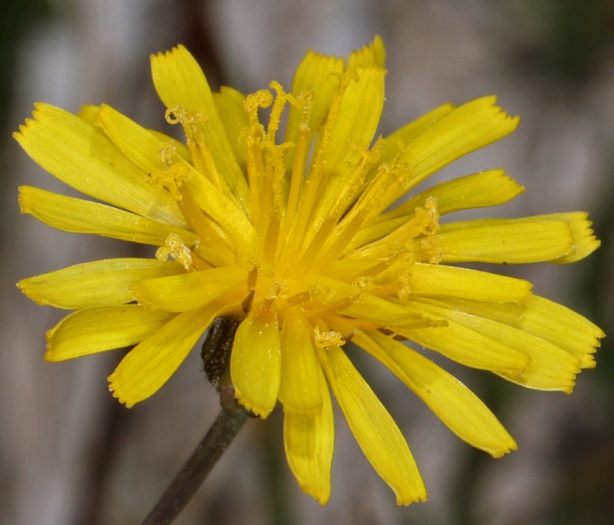Fiddleleaf Hawksbeard
(Crepis runcinata)
Fiddleleaf Hawksbeard (Crepis runcinata)
/
/

Steve Matson
CC BY 4.0
Image By:
Steve Matson
Recorded By:
Copyright:
CC BY 4.0
Copyright Notice:
Photo by: Steve Matson | License Type: CC BY 4.0 | License URL: http://creativecommons.org/licenses/by/4.0/ | Rights Holder: Steve Matson | Publisher: iNaturalist | Date Created: 2008-06-23T12:13:02-07:00 |

























Estimated Native Range
Summary
Crepis runcinata, commonly known as Fiddleleaf Hawksbeard, is a perennial herb native to grasslands, meadows, and open areas in western and central Canada, the western and central United States, and extending into northern Mexico. It typically grows to an erect height of up to 31 inches (79 cm). The plant is characterized by its mostly leafless stem and a basal rosette of hairless leaves, each deeply lobed with tooth-like projections. The inflorescence consists of clusters of bright yellow ray florets, resembling small daisies, and lacks disc florets. After flowering, it produces small, dry fruits (achenes) topped with a tuft of bristles (pappus) that aid in wind dispersal.
Fiddleleaf Hawksbeard is valued for its low-maintenance nature and its ability to thrive in a variety of soil conditions, although it prefers well-drained soils. It is drought-tolerant once established, making it suitable for xeriscaping and naturalized areas. In gardens, it can be used in wildflower meadows or as part of a mixed perennial border. It is also appreciated for its extended flowering season, which can add color to landscapes from late spring to early fall. While generally not prone to serious pests or diseases, it can occasionally suffer from root rot in overly wet conditions. It is important to note that Crepis runcinata can self-seed prolifically and may become invasive if not managed properly.CC BY-SA 4.0
Fiddleleaf Hawksbeard is valued for its low-maintenance nature and its ability to thrive in a variety of soil conditions, although it prefers well-drained soils. It is drought-tolerant once established, making it suitable for xeriscaping and naturalized areas. In gardens, it can be used in wildflower meadows or as part of a mixed perennial border. It is also appreciated for its extended flowering season, which can add color to landscapes from late spring to early fall. While generally not prone to serious pests or diseases, it can occasionally suffer from root rot in overly wet conditions. It is important to note that Crepis runcinata can self-seed prolifically and may become invasive if not managed properly.CC BY-SA 4.0
Plant Description
- Plant Type: Herb
- Height: 1.5-3 feet
- Width: 0.5-1 feet
- Growth Rate: Moderate
- Flower Color: Yellow
- Flowering Season: Spring, Summer, Fall
- Leaf Retention: Deciduous
Growth Requirements
- Sun: Full Sun, Part Shade
- Water: Medium
- Drainage: Medium, Slow
Common Uses
Bee Garden, Low Maintenance, Water Garden
Natural Habitat
Native to grasslands, meadows, and open areas in western and central Canada, the western and central United States, and northern Mexico
Other Names
Common Names: Fiddleleaf hawksbeard, Runcinate hawksbeard, Fiddle-Leaved Hawksbeard, Naked-Stemmed Hawksbeard, Scapose Hawksbeard
Scientific Names: , Crepis runcinata, Crepis runcinata subsp. typica, Hieracioides runcinatum, Psilochenia runcinata subsp. runcinata,
GBIF Accepted Name: